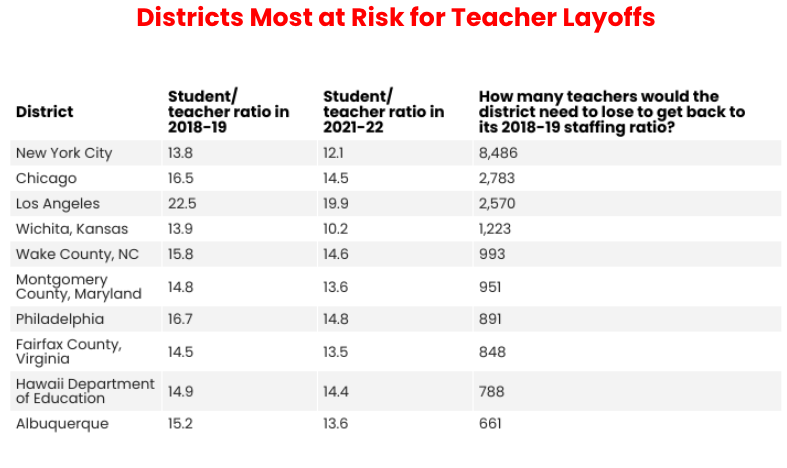Analysis: Schools could lose 136,000 teaching jobs when federal COVID funds run out
Chad Aldeman | November 2, 2023
Your donation will help us produce journalism like this. Please give today.
Objectively speaking, it’s a weird time to be talking about layoffs in schools. According to the Bureau of Labor Statistics, 2021 had the fewest layoffs in public education in the last two decades. Last year was just a bit higher, and so far 2023 is tracking about the same.
There are still pockets of layoffs due to unique local circumstances, but they are by no means widespread.
Still, widespread staff reductions seem very likely to happen in the very near future. Marguerite Roza at the Georgetown Edunomics Lab has called the expiration of federal relief funds in September 2024, combined with unprecedented enrollment declines, a “perfect storm” for school budgets.
As a result, it’s likely that school districts will have to trim their staff in the next two to three years. No one knows exactly when the storm will hit or how bad it will be, but I estimate it could easily result in 136,000 fewer teacher jobs.
Where will layoffs hit the hardest? This question is easy to answer at a high level: The districts most at risk will be those that have lost the most students and those that got the most ESSER money. Those tend to be large, urban, high-poverty districts.
Education Resource Strategies took a more sophisticated look at which states are most at risk, starting with how much the ESSER money represented compared with their typical education budget. Assuming that districts spent the federal money evenly over the entire grant period, this figure ranged from 4% to 5% in states like New Jersey, Connecticut, Colorado and Utah, and up to 12% to 17% in states like Alabama, New Mexico, Louisiana and, especially, Mississippi.
But state-level data are not sufficient to drill down to find districts most at risk. While some places received no ESSER funds at all, the highest-need districts saw influxes totaling up to 40% of their annual budgets.
So, to get a more precise estimate, I looked at staffing ratios and how they have changed over time. About three-quarters of school districts across the country have reduced their student-teacher ratios over the course of the pandemic. That is, they have more staff per student than they used to. For this analysis, I looked to see how many teachers a district would lose if they went back to the same staffing ratio it had in 2018-19.
Take Chicago as an example. According to the latest federal data, its student-teacher ratio shrunk from 16.5 students per teacher in 2018-19 to 14.5 in 2021-22. Over this three-year period, it added 5% more teaching staff even as student enrollment dropped 8%. For Chicago to go back to the same staffing ratio it had just a few years ago, it would need to shrink by 2,873 teachers.
All told, if every district in the country went back to the same staffing ratio it had in 2018-19, the nation would lose 136,000 teaching positions.
Districts wouldn’t have to lay off all those teachers; they could start by letting attrition and slower hiring rates reduce their employee headcount. If state budgets remain strong, that might allow many places to avoid, or at least limit, the number of layoffs.
But it’s also possible that my 136,000 estimate is on the low side. For one thing, districts tend to protect full-time classroom teachers from layoffs, especially higher-paid veterans. That means they would need to lay off many more junior teachers and other part-time employees to make up the difference. Given the makeup of the teacher workforce, that would have devastating effects on diversity efforts aimed at bringing more young Black and Hispanic educators into the workforce.
In one historical parallel, schools lost a similar number of teachers from 2009 to 2010 as the Great Recession began to hit school district budgets. When that happened, it wiped out a decade’s worth of staffing gains as schools shed a total of 364,000 jobs.
So, when might layoffs hit schools? At the moment, the economy looks quite strong. Inflation is falling, and the labor market is as strong as it’s ever been. But the last and biggest pot of federal relief money, $122 billion in ESSER III funds, expires at the end of September 2024, and Congress has given no signs that it will extend that deadline, let alone authorize additional funding to soften the decline.
So school districts mustn’t get complacent. Large urban districts with high concentrations of poverty will likely need to downsize. Districts that spent less of their COVID relief money on labor will be less at risk of needing to make big layoffs. Districts that are packing a higher share of their spending into this final year are especially vulnerable to hitting a big fiscal cliff.
There are a lot of uncertainties about the exact timing and magnitude of the impact, but districts will have to scale back their budgets in the coming years. By my estimates, that could mean as many as 136,000 fewer teachers.

